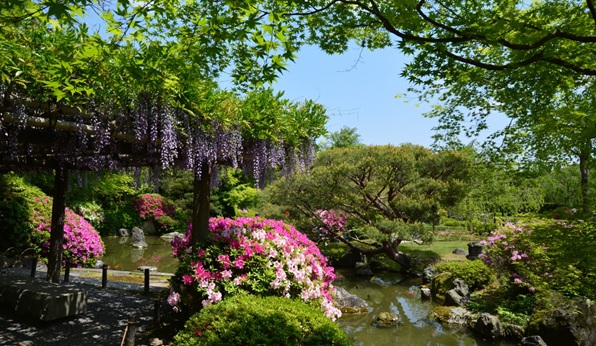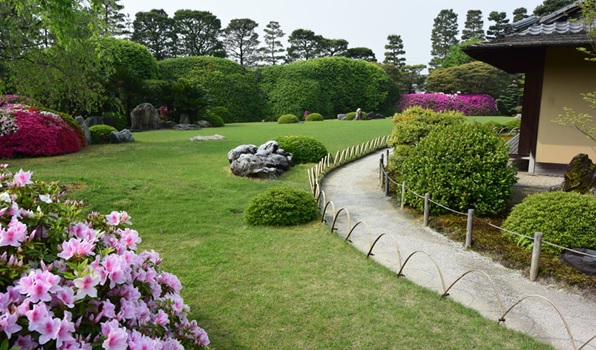The Rakusuien garden, which completely surrounds the shrine buildings,
is composed of five distinct gardens, depicting the evolution of Japanese
gardens. A stroll through the garden is akin to walking through time. The
garden has 150 plum trees, 300 camellia bushes and close to 100 maple trees.
It also grows all the plants (over 80 kinds) that appeared in The Tale
of Genji, the epic novel written in the Heian Period. Discover the Japanese
love of nature; flora lies at the heart of the elegant Heian culture.
The entrance (1) is beside the Amulet Office, just inside the vermiliontorii.
(Admission: 9 a.m.–4 p.m., year round.)
- Spring Mountain(2)
 This manmade mountain is a remnant of Jonan Rikyu, the retired Emperor
Shirakawa’s villa. In spring, it is abloom with more than 150 weeping plums
and numerous varieties of camellias. From June 25 through 30, visitors
to Jonangu can participate in the Hitogata Nagashi purification ritual.
Worshipers cleanse themselves of the sins and impurities they accumulated
over the previous six months and pray for good health by floating paper
human figures down the purification stream.
This manmade mountain is a remnant of Jonan Rikyu, the retired Emperor
Shirakawa’s villa. In spring, it is abloom with more than 150 weeping plums
and numerous varieties of camellias. From June 25 through 30, visitors
to Jonangu can participate in the Hitogata Nagashi purification ritual.
Worshipers cleanse themselves of the sins and impurities they accumulated
over the previous six months and pray for good health by floating paper
human figures down the purification stream.
- Heian Garden(3)
 This garden is modeled on the gardens found in the residences of the Heian
aristocracy. It comprises a pond, an island, two streams, and a terraced
waterfall. The nobles would enjoy their gardens in all seasons with pleasure
boat rides on the pond, cherry-blossom viewing parties, and poetry-composition
gatherings. Reminiscent of these glorious times, the Kyokusui-no-Utage
poetry-composition gathering is held along the back stream, twice annually.
The fresh verdure of spring imbues visitors with the vitality of life,
and the turning colors in fall reflect brilliantly on the pond’s surface.
This garden is modeled on the gardens found in the residences of the Heian
aristocracy. It comprises a pond, an island, two streams, and a terraced
waterfall. The nobles would enjoy their gardens in all seasons with pleasure
boat rides on the pond, cherry-blossom viewing parties, and poetry-composition
gatherings. Reminiscent of these glorious times, the Kyokusui-no-Utage
poetry-composition gathering is held along the back stream, twice annually.
The fresh verdure of spring imbues visitors with the vitality of life,
and the turning colors in fall reflect brilliantly on the pond’s surface.
- Muromachi Garden(4)
 Tea ceremony, ikebana, Noh drama, and other traditions and arts flourished
during the Muromachi period (1336–1573). This garden style popular at the
time was majestic with stone configurations throughout. The waterfall,
named Medaki (or Female fall), in the foreground trickles softly. In contrast,
waterfall at the back of the pond, called Odaki (or Male fall), plummets
vigorously. In the pond’s center stands Horaijima – the island of the immortal
hermit – on which grow pines, symbols of longevity. The triad cluster of
stones on the opposite bank represents Buddha flanked by two Bosatsu in
the ideal Buddhist world. The dock beside Odaki is designed to allow people
to board boats and journey the ideal world of Buddha. The pond, which is
inhabited by koi, is especially stunning when the wisteria bloom in late
April, when the azaleas flower in May, and when the colors turn in autumn.
Tea ceremony, ikebana, Noh drama, and other traditions and arts flourished
during the Muromachi period (1336–1573). This garden style popular at the
time was majestic with stone configurations throughout. The waterfall,
named Medaki (or Female fall), in the foreground trickles softly. In contrast,
waterfall at the back of the pond, called Odaki (or Male fall), plummets
vigorously. In the pond’s center stands Horaijima – the island of the immortal
hermit – on which grow pines, symbols of longevity. The triad cluster of
stones on the opposite bank represents Buddha flanked by two Bosatsu in
the ideal Buddhist world. The dock beside Odaki is designed to allow people
to board boats and journey the ideal world of Buddha. The pond, which is
inhabited by koi, is especially stunning when the wisteria bloom in late
April, when the azaleas flower in May, and when the colors turn in autumn.
- Momoyama Garden(5)
 Momoyama Garden, which lies to the south of the tea house, is a karesansui garden that depicts the sea without actually using water. It is an open
garden reflecting the magnificent traits of the Momoyama Period (1573–1603).
During this period, Japan came into contact with European culture. The
warrior class aspired to unify the entire nation, and the military commanders
built grand castles. The manicured trees at the back represent Japan’s
mountains; the expansive lawn, the Pacific Ocean; and the stones dotting
it, the islands off Japan’s coast. The pine pruned in the shape of a ship
in the back right is imagined to be a ship arriving from Europe. When appreciating
this scene, it is hard not to be moved by the spirit of the voyagers as
they finally reach the golden nation of Zipangu – as Japan was known at
the time – at the end of their long voyage. The garden is especially beautiful
in April when the cherry blossoms bloom, followed by the azaleas.
Momoyama Garden, which lies to the south of the tea house, is a karesansui garden that depicts the sea without actually using water. It is an open
garden reflecting the magnificent traits of the Momoyama Period (1573–1603).
During this period, Japan came into contact with European culture. The
warrior class aspired to unify the entire nation, and the military commanders
built grand castles. The manicured trees at the back represent Japan’s
mountains; the expansive lawn, the Pacific Ocean; and the stones dotting
it, the islands off Japan’s coast. The pine pruned in the shape of a ship
in the back right is imagined to be a ship arriving from Europe. When appreciating
this scene, it is hard not to be moved by the spirit of the voyagers as
they finally reach the golden nation of Zipangu – as Japan was known at
the time – at the end of their long voyage. The garden is especially beautiful
in April when the cherry blossoms bloom, followed by the azaleas.
- Jonan Rikyu Garden(6)
 This karesansui garden depicts the area around Jonangu at its most splendid during the
Heian Period. The flat stones of the garden path represent the Kamo River,
which flows through Kyoto; the sea of white pebbles, the imperial villa’s
pond; the grass, land; and the rocks, the residence and surrounding buildings.
Let your imagination run wild, and picture in your mind a time when the
aristocracy gathered at the villa and the samurai vied to better each other
in prowess.
This karesansui garden depicts the area around Jonangu at its most splendid during the
Heian Period. The flat stones of the garden path represent the Kamo River,
which flows through Kyoto; the sea of white pebbles, the imperial villa’s
pond; the grass, land; and the rocks, the residence and surrounding buildings.
Let your imagination run wild, and picture in your mind a time when the
aristocracy gathered at the villa and the samurai vied to better each other
in prowess.
English Page Top Festivals Precinct Garden(Page of top) Amulets Access